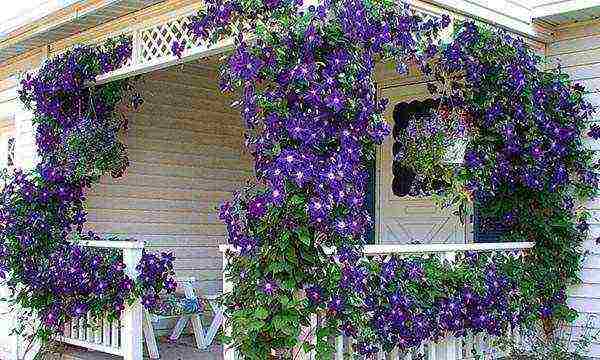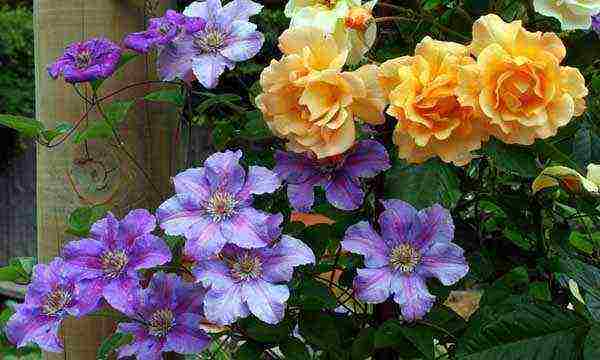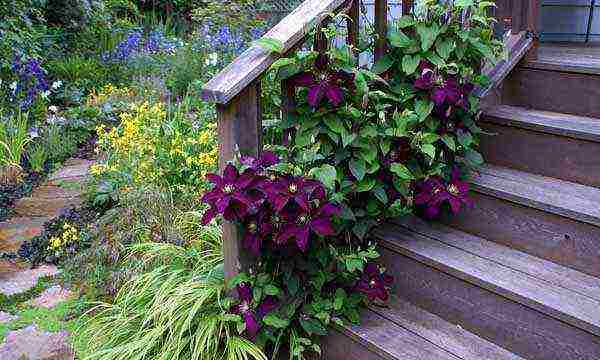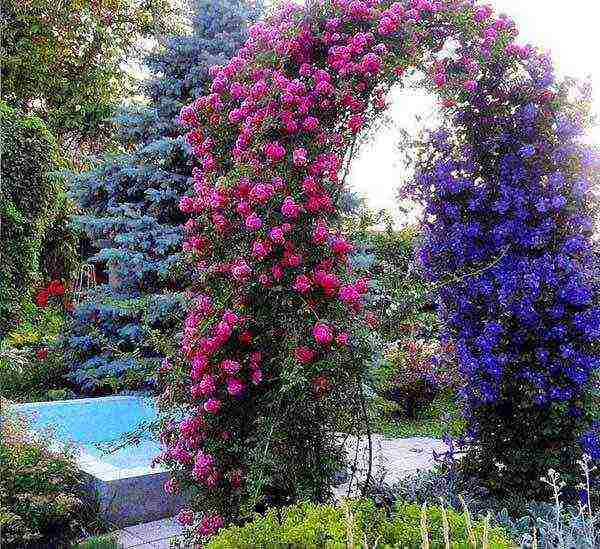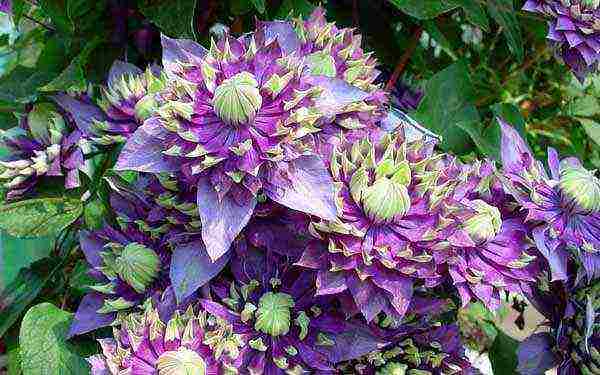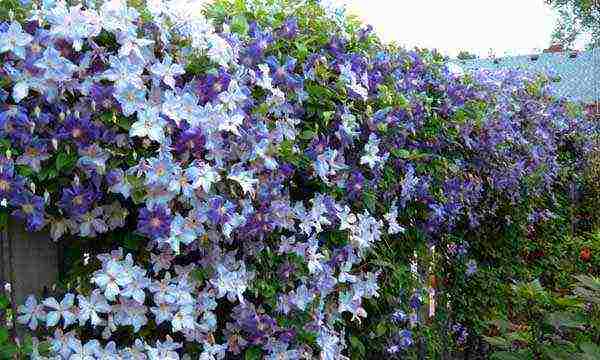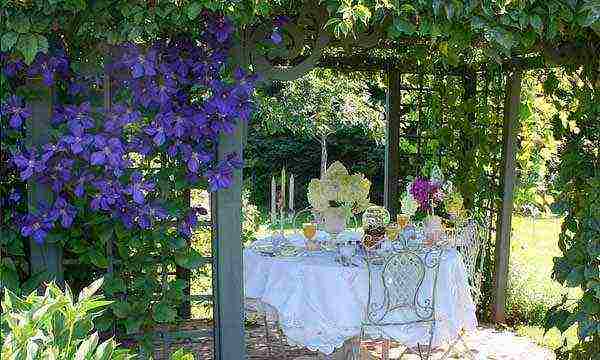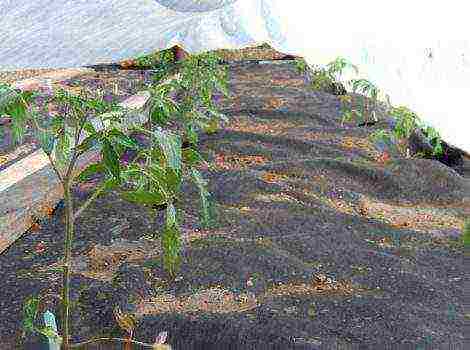Content
- 1 Planting clematis in the spring
- 2 Highlights of clematis planting
- 3 How to care for clematis in the spring
- 4 Top dressing of clematis
- 5 Clematis planting and care in the open field.
- 6 Planting clematis - tips for novice florists.
- 7 Why does clematis not bloom?
- 8 Where to plant clematis.
- 9 Features of watering.
- 10 How to feed clematis.
- 11 Tricks of experienced florists for lush bloom.
- 12 How to propagate clematis by cuttings and shoots.
- 13 How to properly prune clematis to have more flowers.
- 14 Do I need to cover clematis for the winter.
- 15 Clematis in the country
- 16 Tip 1. Clematis where to plant
- 17 Advice 2. Rules on how to plant clematis in open ground in the country
- 18 Tip 3. How to care for clematis
- 19 Advice 4. How to feed clematis in spring for lush flowering
- 20 Tip 5. Supports for clematis with your own hands
- 21 Tip 6. Shelter from cold temperatures
- 22 Tip 7. How clematis reproduces
The main points of caring for clematis immediately after planting:
They are divided into 3 groups: blooming in spring from April to May, blooming in early summer, and blooming in July and later.
There are also several types in height: growing less than 1 m - herbaceous, over 3 m - climbing, grape-leaved and their types - up to 10 m. (See the varieties of clematis varieties here.)
It is for this reason that clematis should be planted correctly, since they are able to live for more than one year in one place.
The rules for growing snapdragons at their summer cottage, read on our website.
You can find out the features of petunia care at home here.
Growing graceful zinnia:
Planting clematis in the spring
For planting clematis, the most favorable seasons are autumn and spring. Saplings can go through the survival period much worse in the first year if the planting of the flower is delayed.
This is due to a failure in the life cycle of the plant, since clematis has an early growing season. This means that you need to plant on time in the spring.
If clematis is planted in the autumn, then you can be sure that it will take root quite well. You just need to know that by the onset of the winter cold, the flower must be allowed to take root properly. Thus, the topic of timing becomes relevant again.
As soon as the buds begin to swell or have not even begun to grow, from about April or early May, you can safely plant clematis.
For the correct planting of the plant, wide and deep enough holes for planting should be made - 60 cm each.
It is recommended to make drainage from gravel or broken brick 10-15 centimeters thick, if there is groundwater nearby.
After that, a fertile top layer and such fertilizers as: 2-3 handfuls of ash, 50 g of superphosphate, humus from 5 to 8 kg are added to the planting pit. Add 50g of slaked lime to acidic soil.
On the soil, which is scattered in advance in the form of a mound, it is necessary to spread the clematis roots evenly.
As one of the options, the mound can be made of sand, and at the end of planting, the root collar is also covered with sand. Thanks to such manipulations, rotting of the plant will be prevented.
If the vine is old, the root neck is deepened by 10-12 cm, if it is young, then the root neck should be deepened by about 5-11 cm.
Thus, not only will new shoots be formed, but also in summer it will serve as a protection against overheating, and in winter from freezing.
When planting clematis, it is necessary to adhere to the distance between the seedlings of 1-1.5 m. Immediately after the planting process, the plants should be watered abundantly with water, and then mulched.
Find out the peculiarities of planting irises and decorate your site with them.
Rules for planting and caring for decorative onions:
Highlights of clematis planting
1. The plant transplantation tolerance is excellent, which allows you to plant them on a simple bed to grow and strengthen, and after a year or two, plant them in permanent places.
2. A clematis seedling is disinfected in a weak solution of potassium permanganate before planting.
3. After planting, it is imperative to put a support and tie the clematis (temporarily).
The support should be no more than 2 cm in diameter. In general, in the process of growth, the vine needs a two- or even three-fold garter of shoots that have grown.
This should be done so that the plant does not suffer from diseases and to reduce the risk of mechanical damage.
4. Active growth of only one stem is observed in large-leaved clematis species in the first year of planting. And in the year when the plant is planted, the top should be pinched, so the lateral processes will begin to grow. The pinching procedure itself can be done again.
5. Clematis is very fond of light, but not overheating of the root system. That is why it is very good to plant flowers such as marigolds, peonies, phloxes and others near it.
6. Since the liana plant is at risk of overheating and drying out the soil, then in the spring, after loosening and the first watering, it is necessary to mulch with humus in northern places, sawdust in the southern regions or peat. And in order to close the shoots at the bottom and avoid overheating, it will be enough to "knock out" the flyer.
7. If the plant is to be planted against a wall, the best side would be the southwest or south side of the building. The distance for good plant growth should be at least 50 cm from the wall. Under no circumstances should water from the roof fall on it.
Where you should not plant a liana plant called clematis:
- in places where there are drafts;
- where there is deep partial shade or absolute shadow;
- in the lowland, namely in those places where the accumulation of moisture and its stagnation is likely;
- it is also not advised to plant clematis close to buildings.
How to care for clematis in the spring
If you grow clematis correctly, then you need to remember about frequent and abundant watering for several years after planting.
After three years, it will be enough to water several times a week 2-3 buckets of water under the bush.
Luxurious and beautiful blooms are the result of proper watering.
To keep moisture in the right amount, you should mulch and loosen the ground near clematis. For the mulching procedure, you can use rotted sawdust, peat or humus.
During the first year of growth of the liana plant, roots are actively developing and, in total, about 3 shoots are added.
Therefore, in order to develop many tens of clematis shoots and obtain a lush shrub with more than one hundred charming flowers, you need to properly and carefully take care of the plant for about 5-6 years. For this, flowers that grow in a single quantity are best cut off.
Already starting from 3 years of growth, clematis is gaining strength, many shoots begin to appear on it. The timing of the flowering of clematis can be well controlled with procedures such as pinching and pruning.
Then the flowering will be completely different and longer, in contrast to plants without pinching and pruning.
Read on our website how to grow a violet.
Growing and caring for lavender at home:
Top dressing of clematis
Clematis are very sensitive to feeding. Therefore, they need fertilization, preferably once a week.For top dressing, a complete fertilizer from minerals is used - for 10 liters of water 30 grams of fertilizer, calculated for a volume of 2 sq.m. soil.
In addition to mineral dressing, 1 glass of wood ash for one separately taken plant is also suitable. Another very good fertilizer is mullein (manure).
This top dressing is recommended to be diluted with one part of the fertilizer per ten parts of water.
When the cold comes it is necessary to cover the root system of the plant, but at the onset of spring, you should not rush to open clematis.
Such a precaution is associated with the fact that the vine is afraid of still intermittent frosts and the sun, which shines brightly, which can lead to kidney damage.
As soon as the spring frosts recede, you can safely remove the shelter from the plant.
After feeding should be done nitrogen fertilizer. One of the good options would be urea - 40 grams for 10 liters of water. If the soil under clematis is acidic, then the best watering agent will be milk of lime in a proportion of 1 square meter of soil - 200 g of slaked lime for 10 liters of water.
The process of undressing the plant is best done in less sunny, better cloudy weather. It is recommended to even make them a little shade so that clematis gets used to the sunlight gradually.
The main points of caring for clematis immediately after planting:
- it is necessary to immediately shade clematis and make protection from the wind;
- water the plant abundantly, but in no case pour it!
- regular weeding and loosening of the soil;
- do not feed immediately after disembarkation!
Clematis flower is a beautiful climbing arcade, liana-like plant. No one regretted that they brought him in at their summer cottage. After all, these flowers will truly decorate your garden! For 20 years, it lives and blooms beautifully in the same place, without requiring a transplant or any other special attention to itself and at the same time decorating the house with its various flowers.
Competent selection of a place for clematis before planting in open ground
This article will let you know how clematis should be planted in open ground. Indeed, in this article we will try to make out the most important points of growing this plant. On the one hand, this is a light-loving plant, but on the other hand, direct sunlight will lead to shredding of flowers and a depressed state.
He does not like the wind and near groundwater, despite the fact that it is hygrophilous in principle, only stagnant moisture in the roots of the plant can negatively affect.
Launching clematis along the wall of the house is an unsuccessful idea, it threatens either the plant getting under the drain, or due to the lack of ventilation, it threatens with an abundance of insects or fungi.
Ideally, the landing site should be removed from the walls of the house by 70 centimeters and an arch, trellis, etc. should be installed there as a pore. This will make it easier to care for clematis, there will be access to it from all sides, and streams of waste water from the roof will not flood it on rainy days. For normal life, the distance between the plants should be a meter or one and a half, taking into account their growth after a while.
If you are planning to plant them in several rows, it is better to stretch the beds from north to south, then they will get a lot of sun.
Single bushes prefer the morning sun.
Open ground planting method
By right, clematis can be considered wonderful plants. However, planting and leaving them in the open field must be done competently. If your clematis are with open roots or in peat pots, then it is better not to pull with planting. When and where is the best time to start planting?
This is done in April or early May, before the active growth of shoots begins. If tightened with planting, it is fraught with a weakened plant until its death.
If, nevertheless, your flower lingered in the house and managed to give active shoots, then planting its open ground in April, when frost is fraught, can destroy it, you will have to plant such clematis in May, and in the second half of it.
If your seedlings have a closed root system, then they can be planted at any warm time, they quickly acclimatize and take root in a new place, especially if they are shaded in a special heat.
In autumn, plants can be planted in the ground from August to October. Even in October, they will have time to put down roots in the ground and prepare for the cold weather. Here, focus on the climate of your region. For the winter, it is worth mulching the soil, covering the plants with spruce branches, leaves or non-woven materials.
Now specifically for the landing itself.
So, if you are wondering what the correct planting of clematis should be, then you can find out this information further. A well-prepared pit is needed for a clematis that has sat up at home. This is important both in spring and autumn.
If the site is presumably with high groundwater, then drainage is simply needed at the bottom of the pit, it is made of broken brick, expanded clay sand or stone chips. Drainage ditches can also be built to drain excess water from flowers.
It is better to prepare the supports on which the flowers will curl and stick in the right place during planting, so that later you will not disturb the flower.
If a bush is planted separately, then he needs a hole 60 cm, and if a group planting is supposed, then it is better to dig a trench, one linear meter for each bush.
After the drainage pad at the bottom has already been prepared, the excavated soil from the pit should be cleaned and mixed with peat and humus in equal proportions. Fertile should be added to the sandy soil. But clay needs sand. And for each bucket of such soil, it is even better to add 100 grams of mineral fertilizing + a liter of wood ash. If the acidity of the soil is increased, dolomite flour or slaked lime, or their analogue, can correct it.
So, with the prepared mixed soil, we fill the hole in the form of a mound to half, we place the seedlings on it, the rhizomes should be straightened in advance. We place the root collar below ground level, and how much depends on the age of the clematis.
If the seedlings are 2-3 years old, then we deepen it by 6-12 cm, the first leaves and buds will go underground. We deepen 3-4 year old plants 5 - 10 cm more. This method will help to overwinter, save from drying out in the heat, and also contribute to the emergence of strong shoots.
After planting, it remains to water, compact, mulch and arrange a canopy over the plant as protection from the sun or wind.
Clematis in the open field. Caring for them
Clematis require special care in spring. And if the landing was carried out correctly, then it is important to pay enough attention to care. In the first year, the flowers get used to a new place, making it easier for them to loosen and weed the soil under them. You need to water it regularly, but not overdo it. If the plant is strong, then it can give buds already in the first year, but it is better to cut them off so that the plant does not waste energy on them. And you need to feed the plant again only after a year, if you followed all the instructions when planting.
As we grow, we fix the shoots on the support. At the beginning of summer, sucking insects can attack the plant, watch your plantings! But closer to autumn, when the humidity is higher and higher, fungi can already overcome. Therefore, one should not neglect preventive and urgent treatments of plants with special means.
A single shoot, which the plant gave out, can be pushed to tillering by pinching. Then you can water deeply and use nitrogen fertilizing. You can add them by the following methods:
- Spraying with a diluted solution.
- Mortar on wet ground.
- Dry, but with loosening and watering.
The acidified soil does not at all contribute to the development of the clematis root system. Lime milk can correct the situation, it needs 200 grams per bucket of water.
But after 3-4 years, difficulties may suddenly appear - if all the rules are observed, the plant suddenly slows down in growth, and its leaves become smaller. A lack of moisture may affect this.Dry soil is compacted, water does not get to the roots, and loosening at depth is impossible. The subsoil irrigation method will come to your rescue, at depth it is very effective. Its essence is in several plastic bottles dug in with the throat down at a distance of 30-40 cm from clematis and during watering they are filled with water, and they, in turn, deliver it to the deep layers of the soil.
Do not forget about decorative pruning, with its help you can always maintain a young and blooming appearance in the plant. Your vine will always bloom lush and delight its owners and their guests.
Let's talk about how to grow luxurious clematis in the country, because many experienced and novice summer residents have seen these spectacular flowers, but at the same time heard that they are capricious in growing. So, most of these popular garden vines are quite hardy, and if properly cared for, they can grow successfully in your garden. After all, all they need is water, ash, top dressing and competent pruning.
Clematis Zhakmana photo
Of course, these flowers do not grow in every country house, but those who grow them are simply in love with them. This resilient, abundantly flowering plant is ready to ennoble the most unsightly corner of your garden. Liana is used to decorate the walls of houses, fences and terraces. Even an old withered tree can "bloom" if such flowers are planted next to it.
Amazing huge flowers and a bush looks decorative even without flowers. And flowering lasts all summer - from early June to August.
Polish Spirit in combination with hyssop, rose and hosta
Clematis planting and care in the open field.
Indeed, it is quite difficult to choose your own variety from this variety of luxurious flowers. One is more beautiful than the other - huge, bright, terry, each simply seeks to outshine the beauty of the others. Each species promises to turn our cottage into a real Garden of Eden! After all, any variety looks beautiful both on its own and in combination with other flowers, especially with roses.
But since we plan not only to admire the flower, but to grow it, then we need to know the peculiarities of caring for it. It is best to buy seedlings in pots, and when choosing a variety, we first of all look not at the shape of the flower, but at its group. It is she who will determine how we will cut it, how to cover it for the winter and when to expect flowering from it.Types of clematis by group and method of pruning:
- First group.
The flowers of the vine will appear only on last year's shoots. Therefore, if you cut off all the old shoots for winter or spring, then you will never see flowering. Flowers from this group are the most luxurious, fashionable and amazing, but they must be covered for the winter.- Second group.
These varieties have flowers on both last year's and new shoots. But, if the variety is double, double flowers appear only on last year's shoots. On young shoots, only inflorescences of a simple form appear and with a short break after the first flowers on old shoots.- Third group.
Flowers appear only on young shoots. No need to cover - cut it almost to the root and that's it. These species are the most unpretentious - they are ideal varieties for beginners, because liana care is simple and straightforward. And although there are almost no double species in this group, believe me, there is plenty to choose from for your treasure.
ERNEST MARКHAM variety. 3 group, height 2.5 m
Planting clematis - tips for novice florists.
When you solve the problem of how to grow a healthy clematis, remember that it absolutely does not tolerate transplantation, so plant them immediately in a permanent place. And in this place, it can grow up to 40 years, provided that you have properly prepared the planting pit.
Clematis Comtesse de Bouchaud photo
How to save a seedling before planting.
If you bought your plant in the supermarket in early spring and you still have to get to the dacha, or, perhaps, it is still too cold for planting, you need to make friends with the plant at home.
Place the seedling pot on the sunniest windowsill.Now we have to disinfect the soil in the pot, because here it is better to play it safe than to hope that it will carry you - after all, you do not want to then treat diseases in our vine. We use Fitosporin for the soil. And in order to support the little liana itself, we use spraying with Epin's solution. And for the roots we will buy Biohumus (instructions on the label). We repeat these procedures every ten days.
How to properly plant clematis yourself.
The potted seedling can be transplanted into the soil after the night frosts have passed. Before planting, the pot with the plant should stand outside in the shade for a couple of days to adapt.
The main thing to remember is that you need to dig a hole for it wide and deep enough - almost the same as for planting an apple tree 60x60x60 cm.If you have groundwater close to you, do not forget to put gravel or broken brick on the bottom of the hole with a layer of 10-12 cm so that the roots of clematis did not rot.
Everything depends on how the plant's root system feels: abundant flowering, brightness of flowers, the number of new shoots and buds. And if the root system grows well and develops steadily, then everything will be in order for you. It is imperative to add peat, humus and sod land to the planting pit, be sure to add glasses of ash. Stir this nutrient mixture in the pit and tamp it lightly. We plant the seedling in a pit at the same level as it grew in a purchased container - the roots should not be deeply buried.
Clematis Etoile Violette photo
Advice. If you want to get a bush with lush flowering, then you need to take care of intensive root formation. To do this, in the middle of the pit we make a hole below the general level by 10 cm and plant a seedling in it. At the same time, we pour a little sand on the root collar of the vine to prevent it from being damaged by putrefactive fungi. During the summer, we gradually pour fertile soil into the hole until it is completely equal to the general level of the planting pit. So we simulate the formation of roots, and with a strong root system, the bush will be healthier and there will be more shoots.
Why does clematis not bloom?
Some plant varieties root very well and can bloom in the first year, others need more time to form the root and therefore they will start to delight us with flowers only in the second or third year.
Where to plant clematis.
Wet swampy soils are completely unsuitable for a plant, so we exclude areas for planting where there is stagnant water or water from roof drains gets in. Such places guarantee fungal diseases and the death of vines. Also, do not plant a vine near large trees - the roots of the plant are large and will begin to compete with the huge roots of the tree.
I want to remind you that the flowers of the creeper love a sunny place, and the roots love the shade. Therefore, it is good to plant low-growing flowers or ornamental grasses next to it. For example, hosts are great companions for creepers. Another option is root mulching. Needles, sawdust or straw are perfect as mulch.
Features of watering.
When watering, try not to water the plant in the center. It is better to make a hole at a distance of 15-30 cm from the stems and pour water into this hole. If you water chaotically in the center of the bush, you will quickly see how your shoots will start to wither - this means that Wilt disease (wilting) has appeared and after that the plant can only be pulled out and burned by disinfecting this place with a solution of copper sulfate. Therefore, it is better not to lead to this.
How to feed clematis.
Clematis Hania photo
The plant throws out a large mass of flowers per season, so the bush cannot do without serious feeding. Once every 10 days, it must be supported with fertilizers that contribute to lush flowering. These are Agricola for flowering plants, Agricola Fantasy, Grow-Up, Effecton for flowering plants.
In the fall, be sure to feed the plant in the winter: 1 tbsp. spoon of superphosphate and 1 tbsp. a spoonful of potassium sulfate in 10 liters of water - carefully move.Pour one bucket of this solution on one adult plant, then next spring the flowers will bloom faster and will delight you until autumn.
Tricks of experienced florists for lush bloom.
To grow a beautiful clematis, one must be aware that they are real gluttons, they must not be fed, but fed regularly and abundantly!
- When to feed clematis. Fertilize the vine every 10 days in small portions of fertilizer, always in liquid form. We start feeding in May, when the growth of shoots begins.
- How to feed:
- 1 tbsp. a spoonful of ammonium nitrate in 10 liters of water or
- cow dung in a ratio of 1:10, or
- bird droppings in a ratio of 1:15 or
- 2 tablespoons of vermicompost per 10 liters of water.
We use one bucket of mortar per bush.- How to fertilize. Alternate mineral fertilizers with organic ones. When buds appear, give both organic and mineral fertilizers.
- We protect against pests. If the soil is acidic, to prevent wilting disease (wilt), you need to deacidify it with milk of lime 200 g of lime per 10 liters of water. Ash is also suitable for this purpose.
- We strengthen the plant. These garden vines love growth stimulants - so spray them with Epin extra every 10 days. This protects them from stress, helps them survive spring frosts successfully, and makes the shoots more active.
How to propagate clematis by cuttings and shoots.
There are three ways: cuttings, shoots and dividing the bush.
Clematis Hagley Hubrid photo
Propagation by cuttings. We harvest the cuttings at the time of bud formation, put them in Kornevin's solution and, when roots appear, plant them in loose soil. Keep in mind that the average percentage of root rooting ranges from 10 to 60% - depending on the variety.
The method of propagation by shoots gives a greater percentage of rooting. Part of the branches of the liana, falling on the ground, begins to form roots. If at this time, without cutting off the branch from the branch, place it in the soil in a peat pot, then after a month, you will be able to separate a healthy rooted seedling from the main bush. It is important to water the potted seedling abundantly.
Dividing the bush assumes that you break an old bush with a shovel into several parts and plant each part in a new place.
How to properly prune clematis to have more flowers.
Liana definitely needs support, moreover, the mesh cells must be large enough - up to 15 cm, then it is easy to remove the vine from them, cut off and cover for the winter.
Clematis Blue Angel photo
If you have a plant for the first year, then in the fall it is cut off almost completely - leaving one bud above the ground. So we stimulate the bush to form new roots and shoots. All subsequent years, it is with the help of correct pruning that we continue to shape and strengthen it.
How to cut clematis of the first group, which form flowers only on last year's branches: in the fall we remove the vine from the support, if the thickened bush we cut off part of the shoots to the roots, we also cut out weak thin shoots, cut all other shoots to a height of 1 to 1.5 m.
How to cut clematis of the second group, which form flowers on both last year's and new shoots: in the summer after flowering, we cut off the flowering part of the old shoot, in the fall we cut out thickened and weak shoots, cut the remaining shoots at a height of 1-1.5 m, then we shorten part of the shoots by another half and we cut off part very shortly - this is how we form a lush bush for the next year.
How to cut clematis of the third group, where our flowers will only be on young shoots, is to trim the shoots almost completely - to the first bud.
If you bought a new seedling of a group unknown to you, prune it as for the second group, and so you can determine the group of your creepers.
Do I need to cover clematis for the winter.
In order to prevent freezing of the lower bud and roots, these vines need to be sheltered from frost.Therefore, before sheltering the shoots, remove all the leaves from them in order to exclude rotting. Then we remove the mulch at the base of the bush and cover the neck of the vine with compost or peat. After that, we spread the stems in a circle in a ring, fasten the stems to the ground with clips of thick wire, cover with mulch on top and cover with a waterproof material, leaving holes for ventilation. In early spring, we release the shoots and tie them to a support.
For all its beauty, clematis frighten some summer residents with the difficulties of growing and caring for. But, if you take care of this amazing and liana correctly, then you will be able to grow wonderful and luxurious flowers in the country, which look especially beautiful when paired with climbing roses.
Clematis are magnificent beautiful climbing lianas from one and a half to 20 meters. Most often, clematis are herbaceous perennials that grow up to one and a half meters. Flowers in some types of clematis grow small, only about 5 cm. There are varieties with significantly large flowers, with a diameter of up to 25 cm. These include varietal clematis blooming in all shades of red, even purple and almost black. Leaves in many varieties can cling to any support with petioles. In the axils of the leaves, buds are laid, which form shoots ending in a flower or inflorescence. In autumn, shoots die off to the level of snow cover. In spring, shoots develop again from dormant buds or from buds preserved under a layer of snow. Clematis roots are thin, light brown or thick brown. The root system penetrates into the depth of the soil up to a meter.
Clematis in the country
Clematis is a curly perennial flower that is mainly used for vertical landscaping. Plants bloom in early summer and, in good weather, can bloom until the end of October. That is, these are flowers blooming all summer.
- Plants look great when planted singly or in groups.
- With the help of clematis, gazebos, walls of houses are decorated, they mask the unsightlyness of outbuildings.
- Having planted clematis in large pots or containers, the hostess can transfer them to new places.
- Some varieties of clematis can be used for forcing indoors and cut into bouquets. Flowers can stand in water and keep their freshness for up to 10 days.
Tip 1. Clematis where to plant
Clematis in the country prefer to grow in a lighted, sheltered from the wind. The soil for them must be nutritious, slightly alkaline, and breathable. Clematis should not be planted on peaty, heavy moist and clayey soil, and in the shade. The soil near the plant will have to be shaded to protect the roots from overheating.
Tip 2. Rules for planting clematis in open ground in the country
- If the soil is wet, then the soil must be artificially raised and only then can clematis be planted.
- The planting holes are dug 60 × 60 cm, at a distance of about a meter. After 3 years, when the plant grows, you can thin out the flowers by transplanting it to another place or give it to a neighbor.
- The bottom of the hole is 10 cm filled with pebbles, gravel or broken brick.
- If the soil is clay, then the soil is removed, replacing it with humus, compost, or garden soil with the addition of sand. With slightly acidic or neutral soil, 500 g of lime or 1 kg of chalk is poured into each hole. As a fertilizer, 200 g of nitrophoska is added to the hole. It can be replaced with bone meal. After planting, the soil around the plant is compacted so that the earth does not settle.
- When to plant clematis in open ground in spring - Plants are planted in late spring. Layers or rooted cuttings are used as planting material.
- When planting, the plants are buried in the soil under the root collar, and the roots are gently straightened. If the buds have started to grow or the shoot is short, then when planting they are only slightly sprinkled with earth. As the shoot grows, soil is added to the hole.
- Clematis must be planted at a distance of half a meter from buildings so that water from the roof does not fall on them.
Tip 3.How to care for clematis
Caring for clematis in the spring in the country is a must.
- Usually this is weeding and loosening the soil.
- How to water clematis - clematis needs to be watered rarely, but abundantly.
- How to feed clematis - 4 fertilizing with mineral fertilizers is carried out per season. For feeding, 40 g of fertilizer is poured into a bucket of water and stirred. This is enough for 4 adult plants. You can use mullein infusion as a fertilizer. You need to feed after watering or rain.
Tip 4. How to feed clematis in spring for lush flowering
If you want to grow a beautiful blooming clematis, then you need to understand that these flowers are real gluttons, they should not be fed, but fed regularly and abundantly!
- Top dressing of clematis is applied every 10 days in small portions of fertilizer and always in liquid form.
- The very first feeding of clematis in the spring, in May, when the growth of shoots begins. How to feed clematis in May: 1 tbsp. a spoonful of ammonium nitrate per 10 liters of water or cow dung at a ratio of 1:10, or bird droppings at a ratio of 1:15 or 2 tablespoons of vermicompost per 10 liters of water. Pour one bucket of solution per bush.
- Top dressing of clematis in spring for flowering alternates. Apply mineral fertilizers and then organic fertilizers in turn.
- When buds appear, you need to simultaneously feed clematis with organic and mineral fertilizers.
- Protect clematis from pests. If the soil is acidic, to prevent wilt disease of clematis (wilt), you need to deacidify it with milk of lime 200 g of lime per 10 liters of water. Ash is also suitable for this purpose.
- Strengthen clematis. These curly flowers love growth stimulants - so spray them with Epin extra every 10 days. This protects the clematis from stress, helps them survive the spring frosts successfully and makes the shoots more active.
Tip 5. Supports for clematis do it yourself
For clematis, it is necessary to put supports. With their help, plants can grow upward. An ordinary ladder, knocked down from thin slats, the steps of which are shifted in different directions, can serve as a support. You can build something like a fan out of strong wire. The diameter of the support should be thinner than 2 cm; with a larger diameter, the plants will not be able to wrap around it. The support looks like a mushroom with a cap. The supports will have to be installed along with the planting of the plant. Otherwise, with a later delivery of the supports, the root system can be disturbed. Trees and shrubs can serve as a support.
Tip 6. Shelter from cold temperatures
With the onset of cold weather, the plant is shortened to 15 cm and sprinkled with soil. But shoots with buds are carefully cut off and laid on a low support, attached to the soil with strong wire. Cover with spruce branches or straw from above. Then they cover it with boards, roofing material. With the first warm days, the shelter is gradually removed and the soil is shoveled.
Tip 7. How clematis reproduces
Clematis is propagated by dividing a non-earthed and earthed bush, by layering.
- You need to start dividing the clematis bush after the snow melts and before the shoots begin to grow. Carefully dig out the bush, shake it off the soil and divide it into separate parts with a knife. It is necessary to divide so that several buds are preserved on each part. The cut points are sprinkled with crushed charcoal. If there are no visible buds on the part, then they may appear when the plant is sprinkled with moist soil. Sprouts usually appear after 3 weeks. They are grown throughout the year and planted in a permanent place.
- In the spring, the soil is raked from the bush so that new shoots grow faster. When they grow up to half a meter, the plant is again covered with a fertile 15 cm layer of soil.All season, the bush will have to be constantly watered. By the beginning of September, adventitious roots are formed on the shoots. The next season, the soil is raked away from the plant, the shoots are separated from the main plant and planted separately.
- Reproduction of clematis by layering.In the spring, when the bush grows to 1 meter, 1-2 stems are separated from it, deepened into the groove by 5 cm and pinned. After 2-3 days, the twig will rise, then the groove is covered with soil. In the fall or next spring, the cuttings will take root, it will have to be separated from the main plant.
After admiring the clematis all summer long, a seedling with buds can be transplanted into a voluminous pot and put on the windowsill. The soil in the pot must be regularly moistened, highlighted with a phytolamp, then flowers will appear in a month. After flowering, the leaves must be removed from the plant and taken to the basement. Moderate watering will save the seedling until spring, when it will again please the owner with flowering.
